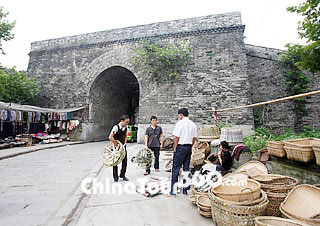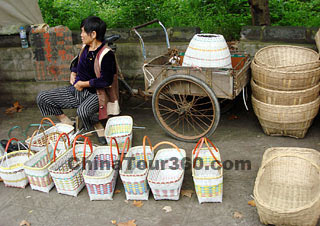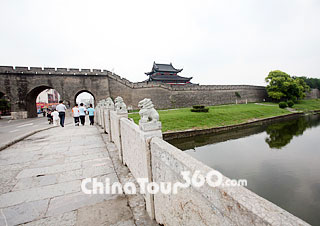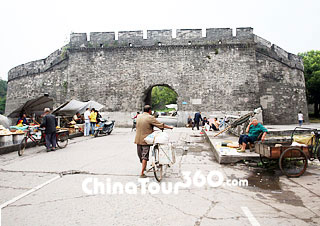 Jingzhou Ancient Town
Jingzhou Ancient Town Local People
Local People The Moat and City Wall
The Moat and City Wall Ancient Jingzhou City
Ancient Jingzhou City Jingzhou Museum
Jingzhou Museum
![]() Facts
Facts
Phone Code: 0716
Postal Code: 434000
Area: 14,104 square kilometers (5,445 square miles)
Population: 6,457,300 (2010 statistics)
Nationalities: Han, Hui, Tujia, Manchu, Mongolian, Miao, Dong, Zhuang
Neighboring Areas: Wuhan, Yichang, Jingmen, Xiangyang, Changde
Location: Jingzhou City lies at the south central of Hubei Province; it is an important port city in Sichuan, Hunan and Hubei areas. The latitude is between 29°26′ and 31°37′N, and longitude between 111°15′ and 114°05′ E.
Physical Features: Jingzhou is near the lower reaches of Yangtze River and the hinterland of the Hanjiang River Plain. 78.7% of the city is flat land while and the rest is hilly. Nearly one hundred streams flow through the city.
![]() History: During the Eastern Zhou Dynasty (770 – 221 BC) the Chu State was founded in Ying City, aka Jinan City, about 4 km north of the present Jingzhou Old City. It was heavily contested by rival armies during the Three Kingdoms Period (220 - 280), and the subject for minstrels to spin the classic folklore of The Romance of Three Kingdoms.
History: During the Eastern Zhou Dynasty (770 – 221 BC) the Chu State was founded in Ying City, aka Jinan City, about 4 km north of the present Jingzhou Old City. It was heavily contested by rival armies during the Three Kingdoms Period (220 - 280), and the subject for minstrels to spin the classic folklore of The Romance of Three Kingdoms.
![]() Attractions: It is rich in history and culture. It was an ancient battleground, especially during the Three Kingdom Period, thus many Relics of Three Kingdoms are found in the city, including the Jingzhou Ancient Town, Guangong Temple, Zhanghua Temple and Huarongdao. Many relics unearthed are kept in the Jingzhou Museum. More over, the city also boasts beautiful natural scenery. Natural reserves including Weishui River Scenic Area, Honghu Lake Holiday Resort and Elk Natural Reserve become popular holiday resorts.
Attractions: It is rich in history and culture. It was an ancient battleground, especially during the Three Kingdom Period, thus many Relics of Three Kingdoms are found in the city, including the Jingzhou Ancient Town, Guangong Temple, Zhanghua Temple and Huarongdao. Many relics unearthed are kept in the Jingzhou Museum. More over, the city also boasts beautiful natural scenery. Natural reserves including Weishui River Scenic Area, Honghu Lake Holiday Resort and Elk Natural Reserve become popular holiday resorts.
![]() Transportation:
Transportation:
![]() Air: None direct. Visitors can take a flight to Yichang Sanxia Airport and then bus into Jingzhou.
Air: None direct. Visitors can take a flight to Yichang Sanxia Airport and then bus into Jingzhou.
![]() Train: Visitors can take a train directly to Jingzhou. In addition, the Wuhan-Yichang high-speed rail that passes Jingzhou will be operational soon. Visitors can expect to reach Jingzhou from Wuhan by the high-speed train within 1.5 hours.
Train: Visitors can take a train directly to Jingzhou. In addition, the Wuhan-Yichang high-speed rail that passes Jingzhou will be operational soon. Visitors can expect to reach Jingzhou from Wuhan by the high-speed train within 1.5 hours.
![]() Bus: There are 49 bus lines in the city. The bus fare is CNY 1 per person, and some buses charge by distance. The service time for most buses is from 06:00 to 19:00. Visitors need to take small change for paying self-service tariff.
Bus: There are 49 bus lines in the city. The bus fare is CNY 1 per person, and some buses charge by distance. The service time for most buses is from 06:00 to 19:00. Visitors need to take small change for paying self-service tariff.
![]() Intercity Bus: Long-distance bus is the most commonly used to get to the city since flight and trains may not be accessible. There are many long-distance bus stations, including the Jingzhou Long-distance Bus Station, Taihu, Shashi, Hongcheng and Jingjin Road long-distance bus stations. Buses from major cities, such as Shanghai, Xian, Shenzhen, Hankou, Wuchang and Changsha, can reach Jingzhou.
Intercity Bus: Long-distance bus is the most commonly used to get to the city since flight and trains may not be accessible. There are many long-distance bus stations, including the Jingzhou Long-distance Bus Station, Taihu, Shashi, Hongcheng and Jingjin Road long-distance bus stations. Buses from major cities, such as Shanghai, Xian, Shenzhen, Hankou, Wuchang and Changsha, can reach Jingzhou.
![]() Taxi: Taxies running in the city are light blue and red cars identified with a sign “TAXI” on the top.
Taxi: Taxies running in the city are light blue and red cars identified with a sign “TAXI” on the top.
![]() Weather: The city lies within a subtropical monsoon region with four distinct seasons: warm but windy spring, hot and rainy summer, cool but sunny autumn and cold winter. The average annual temperature is 16.5 °C (61.7 °F), and the rainy season occurs between April and October.
Weather: The city lies within a subtropical monsoon region with four distinct seasons: warm but windy spring, hot and rainy summer, cool but sunny autumn and cold winter. The average annual temperature is 16.5 °C (61.7 °F), and the rainy season occurs between April and October.
![]() Dining and Shopping:
Dining and Shopping:
You should try a taste of the “Three Treasures of Jingzhou” during your trip in the city, which are Steamed Fish Cake, braised pork and Steamed Sticky Rice. There are also many tasty snacks, such as fried eel, preserved duck egg and fried glutinous rice cake. Many local snacks can be found in Shashi district, East Gate and Guandi Temple at Old South Gate.
For the keen shopper, Beijing Road, Zhongshan Road Pedestrian Street, Time Square, Zhongbai Shopping Mall, Zhongshang Department Store and New Century are all big shopping centers in Jingzhou.







